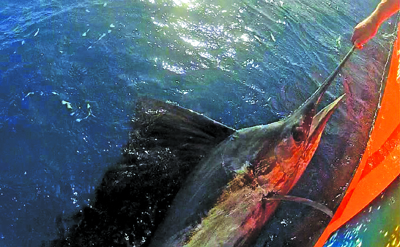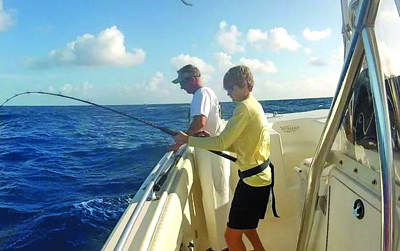Art of kite fishing a new technique

By Nathan and Ted Miller
The month of January brings heavy winds offshore. It also brings great species of sport fish to our area. The technique in targeting these pelagics off the First Coast generally consists of trolling multiple baits at a time (artificial, natural, or both) usually between 4 – 6 knots slow trolling, or 12 – 18 knots high-speed trolling.
But there is another technique that has generated a lot of interest, mainly in the Atlantic off South Florida and the Florida Keys this time of year. This technique is the art of kite fishing.
We use the term “art” as it is reminiscent of a conductor directing an orchestra.
The technique requires constant management and control of multiple lines (six or more) to ensure the presentation is maintained precisely as the angler intends. Anything less than perfection defeats the purpose and benefit of using kites.
The idea is to present live baits in a natural way, without a lot of line and terminal tackle in the water like trolling. Pelagic fish have keen sight, and heavy line, snap swivels and hooks can be seen sometimes and can certainly deter bites.
Kite fishing (if done correctly), keeps all the metal and heavy terminal tackle out of the water, presenting just the live bait.
Using a kite is a similar concept to trolling with outriggers. Release lips are used at various locations on both to keep different baits spread out to cover different areas along the surface. And these clips are designed to open and release the line once the pressure of a strike is applied.
The main difference between using kites and outriggers is kites are used when the boat is drifting, not in motion.
Kite fishing equipment
One of the first items is the obvious: fishing kites. Most anglers who kite fish use two at a time. But more could be needed to ensure you have the proper equipment as conditions change (more or less wind). Some are designed to fly better in more wind, some better in less.
Next item would be electric reels (one or two, depending on the number of kites you fly at one time). The electric reels would be placed on a kite rod, usually around 3½ feet, which is shorter than the typical rod.
Small lead split shots or weights strategically placed to the kites will allow the angler to fly two at once. Attaching weights on the left side of the kite will make it fly left. Adding weights to the right will make it fly right. This is critical in keeping them apart from each other if the angler intends to fly two at one time.
Small balloons should be used and attached to the upper side of the kites to ensure the kite will float in the event it falls to the water.
Two or three release clips will be secured to each kite line at different locations. Each clip will hold the mainline from their respective rod at different locations below the kite line. The clips will release with the pressure of a strike and the angler can continue to fight the fish.
The mainline to each rod is equipped with a highly visible object (typically a bright red cork) to be placed at the connection from the mainline to a 15-foot leader. Knowing the distance from the cork to the live bait will help you know how high or low the bait is in the water column. Ideally, the cork should be kept 15 feet above the surface which lets the angler know the bait is right at the surface. Keeping the bait at the surface keeps the tackle out of the water which should translate into more strikes. Live bait splashing at the surface also sends more of a distress signal which is sure to increase bites as well.
Deploying the kite
When deploying the kite, the electric reel is set in reverse to let line out. The kite slowly rises up and out away from the boat (the angle depends on the amount of wind). The first release clip on the kite line will engage after a few seconds and will deploy along with the kite. The angler stops the electric reel and clips the first main line into the first release clip. This will be the “long” line and where the live bait is the furthest from the boat. The kite is deployed further.
After another 50 feet (plus or minus), the second release clip is engaged. The angler clips the second mainline into the release clip (this will be the “short” line) and continues letting the kite out until this bait is at the preferred distance away from the boat. This process can be continued with another line if you plan on fishing three baits per kite.
The line from the first rod runs up to the furthest release clip on the kite line and continues straight down to the water surface (“long” bait). The line from the second rod runs up to the closest release clip on the kite line and continues straight down to the water surface (“short” bait).
It is important that everyone on board agrees to the terminology. A frustrated captain yelling, “Flying bait right-long” expects everyone on board to know which bait needs to be adjusted quickly. In this case, line would be manually let out on the right side bait, furthest from the boat to lower the bait to the surface.
Once the kite is fully deployed, the rods will be placed in rod holders with an open spool (clickers on) so that a striking fish can take line as the angler begins the count down before setting the circle hooks.
Kite fishing is a great technique for targeting all types of species. Mahi mahi, tuna, wahoo, sailfish and marlin will all be attracted to the live bait that is strategically kept at the surface by the angler. It will also increase chances of witnessing the strike which can be a lot of fun.
Furthermore, the rods and reels used when kite fishing can be downsized to ensure kids will enjoy the experience of fighting a fish with lighter tackle.
Happy New Year!
Send your pictures, stories, experiences and favorite destinations to The Miller Brothers at [email protected] or Ted at [email protected].







